Spring 2022 Newsletter
Saluki Spotlight
SIU Criminal Justice Faculty, and Students Help Evaluate Community Organizations

A research team in the criminology and criminal justice program is helping community organizations to assess and improve their effectiveness in providing services to neighborhoods in a large section of Southern Illinois and the Metro East impacted by economic disinvestment, violence and the war on drugs.
Saluki Student-Athletes Grateful for Support to Succeed During and After College

What do a Carolina Panthers football player, the guidance counselor for a 2,600-student Chicago-area high school and a standout college track/cross-country athlete with a 4.0 GPA have in common? These former student-athletes all chose the SIU College of Health and Human Sciences as the launch pad to help them achieve their goals.
Newsletter Pages
Robert Morgan, Dean, College of Health and Human Sciences
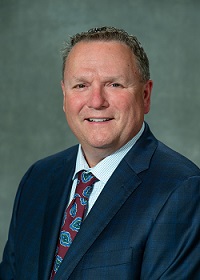
Welcome to our spring 2022 edition of the College of Health and Human Services newsletter. As we continue to move forward toward our new normal post-COVID, I am excited for the continued growth and developments in the college. Our recent Day of Giving was very productive as we received over $70,000 in gifts – we thank all of you who supported the college.
We are already planning for the fall as well. We will host a CHHS Alumni Tailgate for the Homecoming game on October 15, 2022. Details are forthcoming, but please plan now to join us.
We are moving all living learning communities (LLCs) for the college into the Mae Smith residence hall. With this, we are working on branding and updating the facility. Our goal is to provide students the opportunities to engage with each other, peers from other schools, and faculty and staff in a fun and exciting learning environment. But we need your help. We are looking to raise $10,000 to help us with this project. If this is something you are interested in supporting, please reach out to me or Steph Taylor (director of CHHS development: StephanieT@foundation.siu.edu).
I’m also excited to announce the development of a CHHS Dean’s Advisory Council, with a first meeting being organized soon. Full details and members of this important council will be announced in the next newsletter.
Here is a list of upcoming events in the coming months, and if you are in town for one of these or any other event or purpose, please let me know you are coming. I would greatly like to meet with you, share more about all that is happening in the college and at SIU broadly, and learn about your time at SIU and subsequent activities.
- Commencement – May 7, 9 a.m. Banterra Center.
- School of Aviation Golf Scramble – June 27 (Boulder Ridge Country Club, Lake in the Hills, Illinois)
- Sunset Concerts – June 30, July 28
- Move-in day – Aug. 18
- First day of fall classes – Aug. 22
- College Connection – Aug. 25 or Sept. 1
- Saluki football home game – Sept. 10 (Southeast Missouri Red Hawks)
- 70th anniversary of the School of Automotive – Sept. 24-26
- Saluki football home game – Sept. 24 (North Dakota Fighting Hawks)
- Family Weekend – Sept. 23-25
- SIU Homecoming 2022 – Oct. 10-15
- CHHS Alumni Tailgate – Homecoming – Oct. 15
- Saluki football home game – Oct. 15 (Western Illinois Leathernecks)
- Touch of Nature’s Haunted Hallow – Oct. 23
- CHHS Faculty & Staff Appreciation Tailgate – Oct. 29
- Saluki football home game – Oct. 29 (Northern Iowa Panthers)
- Saluki football home game – Nov. 12 (North Dakota State Bison)
Best Wishes and Go Dawgs,
Robert Morgan, Ph.D.
robert.d.morgan@siu.edu
SIU’s fitness program for cancer survivors and caregivers transforms lives, and gives priceless experience in a new facility
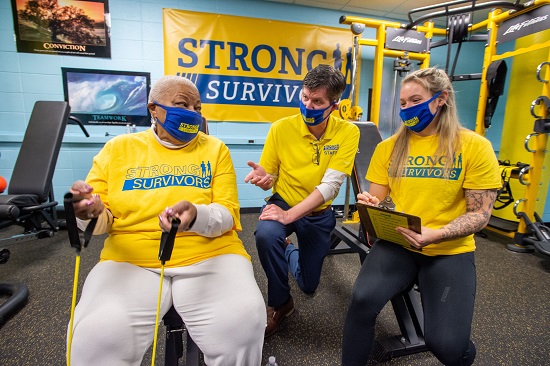 Ann Marie Shepherd, a Strong Survivor from Makanda, exercises under the guidance of Phil Anton, associate professor and exercise science program/Strong Survivors director, and Madeline “Madie” Rushing, a master’s student in exercise science from Carbondale who has been assisting Shepherd since June. (Photo by Russell Bailey)
Ann Marie Shepherd, a Strong Survivor from Makanda, exercises under the guidance of Phil Anton, associate professor and exercise science program/Strong Survivors director, and Madeline “Madie” Rushing, a master’s student in exercise science from Carbondale who has been assisting Shepherd since June. (Photo by Russell Bailey)
By Christi Mathis
CARBONDALE, Ill. — Cancer – it’s a word that strikes fear and changes lives in an instant. It happened to the family of Phil Anton, associate professor and director of the exercise science program at Southern Illinois University Carbondale, when his cousin and childhood best friend, Julie Honerkamp, was diagnosed at the age of 13.
A year older than his cousin, he watched as from ages 13-18 Julie struggled valiantly against osteogenic sarcoma which began in her thigh bone and later spread to her lungs, kidneys, and brain, resulting in her death in 1990. He was determined to honor her life and memory specially. Strong Survivors, one of only two programs of its kind in the country, launched in September 2005 as a joint effort involving Anton, SIU, Southern Illinois Healthcare, and John A. Logan College. The program provided exercise training space a couple of days each week and included nutrition and fitness components.
Today, nearly 1,000 cancer survivors and their families from all over Southern Illinois, along with hundreds of SIU students, are the beneficiaries. And now, Strong Survivors is operating in a new, dedicated facility bearing Honerkamp’s name.
Dedicated space
Anton said he’s thrilled with Strong Survivors’ positive impact on the lives of cancer survivors, caregivers and students, but he was determined to take his vision one step further. He wanted a special space just for the program.
Since 2009, the program has been in Davies Hall, Room 132, an old locker room that had been converted into shared lab space. In 2018, Rooms 123/124 in Davies Hall opened up, and plans were made to create an exercise lab specifically dedicated to the program, a truly private place for cancer survivors and caregivers to exercise with SIU student staff members.
Anton also had another vision, a dream of naming the facility in his cousin’s honor. However, funds were needed to remodel and equip the space and secure naming permission. Generous donors, including Julie’s family, program participants, students and their families, community members, and others, contributed about $40,000 to make the Julie A. Honerkamp Strong Survivors Cancer Rehabilitation Laboratory a reality.
A rare program is launched
In the early 2000s, Anton knew what he wanted to do after learning about an acclaimed cancer survivor program in northern Colorado. Anton had recently joined the SIU faculty, and he and a graduate student began working on a similar program in Carbondale while collecting data for his doctoral dissertation. Gradually, additional SIU students, particularly from the exercise science program, were trained and began assisting.
By 2009, survivors were coming from all over the region as Strong Survivors grew and flourished. The hours expanded, from 7 a.m. to 7 p.m., and so did the timeline. Instead of a 12-week cancer rehabilitation program, people could stay in the program indefinitely.
“We work with people who were diagnosed last week or 30 years ago,” Anton said. “We will work with them at any time in their cancer experience.”
Another change that year was welcoming caregivers – whether family members or friends – to the program.
“Often, the caregivers are in worse physical condition than the survivors when they arrive because they focus so much on the survivor and so much falls on them it translates into psychological and physical stress,” Anton said. “They are often the forgotten soldiers in the cancer battle.”
One thing has never changed though, Anton said. The services are all provided at no cost to participants.
The goal is to help community members and provide a good learning experience for SIU students.
Personal attention
Ann Marie Shepherd, of Makanda, was diagnosed with breast cancer in 2014, resulting in a lumpectomy followed by 36 radiation treatments and two years of hormone-blocking medication before being declared cancer-free in February 2020.
She battled weight gain, equilibrium issues, and knee pain, causing her to fear falling. She began working with SIU student Madeline “Madie” Rushing each Wednesday last June and said she has been “thoroughly blessed to participate in Strong Survivors. My balance is improved, my endurance is greater and I can walk longer distances.”
In addition to in-person workouts, Rushing, a master’s student in exercise science from Carbondale, provides home workouts for Shepherd and sends text messages after each session to Shepherd to report on her progress, note the high points of her workouts, and encourage her. Shepherd shares those texts with her children and family members who in turn provide additional encouragement and support. She said working with the students “keeps me encouraged that I can overcome all of the setbacks.”
Rushing began working in the program last summer.
“It’s been great,” Rushing said. “I look forward to meeting with Ann Marie every week. It’s rewarding work. Her main goal when we started was to be able to walk from her car to her seat at a Saluki game without a cane, and she did it! She’s very hard-working and a real character. I love meeting with her and helping her reach her goals.”
Rushing said the practical experience has already proven beneficial career-wise. She is convinced it helped her secure a position as an exercise specialist in cardiac pulmonary rehabilitation at St. Joseph’s Hospital in Murphysboro recently.
Kathy Morgan, of rural Carbondale, first came to Strong Survivors in the summer of 2006. A breast cancer survivor, as was her sister, she’s been part of the program since 2009.
“I feel better, and I can tell I’m more fit,” Morgan said. She was sad to miss for a time due to the pandemic and noted that a knee problem is already improved since her return. She said the nutrition instruction is very valuable as well.
“I would recommend this program to anyone who has cancer,” she said, pointing out that the students are very supportive and that participants and students form close friendships.
Invaluable involvement
Strong Survivors was one of the things that drew Cailey Clark, a senior exercise science major from Pittsburg, Illinois, to SIU. Her childhood best friend’s older brother, who was also her brother’s best friend, had leukemia, and seeing him fight and how others helped, drew Clark to a career in a health-related field where she could make a difference.
“I heard about Strong Survivors when I was taking a campus tour, and it made me want to come to SIU,” she said. “Then I met Dr. Anton and some of the other faculty and it solidified my decision.”
She plans to become a clinical exercise physiologist, working in a cardiopulmonary lab. She said working in Strong Survivors since fall 2020 has given her absolutely invaluable experience, convinced her of her career plans, and enabled her to form great professional connections through Anton, who has been a wonderful mentor.
She said she has enjoyed another, somewhat unexpected benefit as well. She’s come to think of Kathy Morgan as another member of her family.
“She’s gotten to know me so well that when she’s out shopping at yard sales, she’ll text me and say she’s found a book that she thinks I’ll like and she’ll pick it up for me,” Clark said with a smile.
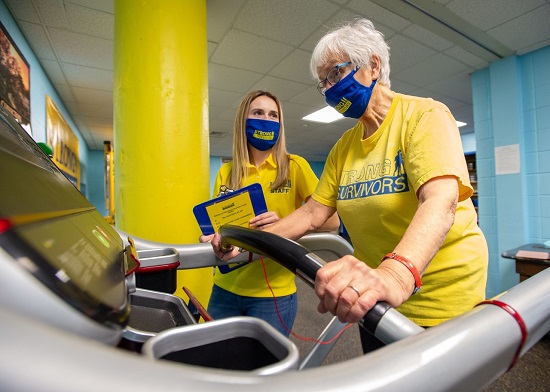 Kiley Carter, a senior exercise science major from Benton, assists Strong Survivor Fran Benson of Carbondale with her workouts and keeps records of the sessions. (Photo by Russell Bailey)
Kiley Carter, a senior exercise science major from Benton, assists Strong Survivor Fran Benson of Carbondale with her workouts and keeps records of the sessions. (Photo by Russell Bailey)
Physical and emotional benefits
Some Strong Survivors have fought cancer multiple times. Fran Benson, of Carbondale, first heard that dreaded word in 1979 then had a worse recurrence in 2002. Four years later, she discovered Strong Survivors and today says, “I give the program all the credit for how good I look and feel.” She had another relapse in 2011, and Anton was the first person she called. She said at one point in her journey, she was so weak, she couldn’t even walk into the building due to her treatments. Her husband would help her come into the building and get her to her sessions.
“I felt like I couldn’t do anything, but I could. It’s like an exercise snack. My energy level started at zero but improved greatly and I’ve been doing it ever since,” she said proudly.
Benson notes that she and her trainer, Kiley Carter, a senior exercise science major from Benton, don’t have an agenda as they go through the workout together, but they enjoy chatting and have become quite close.
“We just talk.” Benson chuckled. “She probably doesn’t have too many 85-year-old friends.”
Carter aspires to be an occupational therapist, enjoys helping people and appreciates the valuable experience she’s getting, but moreover, she values the unique friendship with someone more than 60 years her senior.
“I love it,” Carter said. “I get to learn a lot about what she and the other people have been through. It helps me so much to understand other people.”
Life-changing in many ways
Since its inception, Strong Survivors has provided services to nearly 1,000 survivors and caregivers, Anton said. About 220 students have volunteered their time and energy to serve as trainers for the program. Each is specially trained to do so.
Kathy Renfro, a cancer survivor from Carbondale, has been part of the program since 2019 and said it has been a “game-changer for me. It has given me confidence in my body and a better understanding of the connection between my body and my brain.”
While always active and involved in activities like pickleball, she said Strong Survivors has been transformative for her. She’s been working with Sidney Sikes, a senior exercise science major and Saluki softball player from Dallas, Texas. Sikes plans to go on to obtain her doctorate in physical therapy and said her work with the program has positioned her well for graduate school and beyond.
Brandon Caldwell, a senior exercise science major from Murphysboro, said he looks forward to his time in the lab each week, noting that it gives him a great opportunity to apply lessons he’s learned in the classroom.
“I’m amazed at the participants too, how mentally and physically strong they are, especially after all they’ve been through,” Caldwell said as he assisted Joan Temple of Carbondale with her exercise regimen.
Temple had cancer several years ago, and she and her caregiver husband, Jim, both participate. She said it’s fun and she thinks she’s in better shape thanks to her workouts. She also enjoys staying in touch with the student staff members.
Jim said he appreciates that it “makes her feel better about herself and that it reduces stress levels. The better you feel about yourself, the more it reduces pain and encourages general feelings of wellness. It also gives you something to look forward to, and for many of the people I’ve talked to here, that’s important.”
As a caregiver, he said “one of the worse feelings I have ever had in my life is not being able to do something for someone I love. I was a policeman for over 30 years. I’m used to being able to fix things. I couldn’t fix her cancer but to be able to come here with her is something I can do to take an active role in her recovery. It’s something we can share. It’s good for me too. I’m fairly active, gardening, cutting wood, but this helps me.”
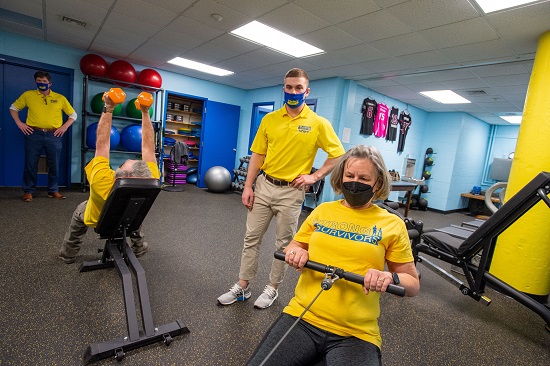 Joan Temple, right, a cancer survivor and Strong Survivor from Carbondale, exercises with assistance from Brandon Caldwell, a senior exercise science major from Murphysboro. At left, her husband, Jim, participates in workouts with her, as Phil Anton, associate professor and exercise science program/Strong Survivors director, watches. Photo by Russell Bailey)
Joan Temple, right, a cancer survivor and Strong Survivor from Carbondale, exercises with assistance from Brandon Caldwell, a senior exercise science major from Murphysboro. At left, her husband, Jim, participates in workouts with her, as Phil Anton, associate professor and exercise science program/Strong Survivors director, watches. Photo by Russell Bailey)
Lab useful for research
The facility is also important for research, Anton said. Data collected there on a daily basis is analyzed by students and faculty. Physical, psychological, and qualitative assessments are made, and papers have been published in a wide variety of journals, including the Journal of the American Geriatric Society and Supportive Care in Cancer.
Anton said the research includes:
- Quantitative studies focus on the performance of daily living tasks and the improvements in lift-and-carry tasks among cancer survivors participating in prescribed exercise.
- Qualitative studies that focus on the participant’s perceptions of the program benefits, their individual quality of life, and factors such as fatigue, social support, and enjoyment of exercise.
- Perceptions cancer caregivers have of an exercise and nutrition program.
SIU Automotive continues its 70-year history of setting the pace

Whether the work was in temporary military buildings or a state-of-the-industry facility, the strength of Southern Illinois University Carbondale’s nationally recognized automotive program continues to resonate through seven decades.
The School of Automotive is celebrating its 70th anniversary in 2022, and while the cars, trucks and various components have definitely changed during that time, the program’s foundation of its people — faculty, students and outstanding alumni support have not.
The program is planning a daylong alumni reunion on Sept. 24, during the university’s Family Weekend, at the Transportation Education Center that will include current students hosting a car meet.
For Neil Swartz, recently retired as a vice president for Toyota North America and current SIU Foundation Board member, coming to SIU Carbondale and learning about the opportunities of an automotive technology education was a game-changer. Swartz earned his applied science degree in automotive technology in 1976 and bachelor’s degree in automotive management in 1978. He initially saw a future as a “capable and fully certified technician.”
“My professors opened my eyes to a much bigger world and the ways I could leverage my automotive technology education in the broader automotive industry,” he said.
“What I found at SIU both surprised and challenged me, and it’s the secret sauce that has made the automotive program the envy of every other automotive school in the country — it is the SIU automotive faculty.
“From the beginning I could sense that these instructors were excited to share what they know with us. Even more fantastic was how hard they worked with the students to make each one of us feel their passion for automotive technology. They truly wanted us to understand, to learn and to grow — most of all they wanted each of us to be successful.”
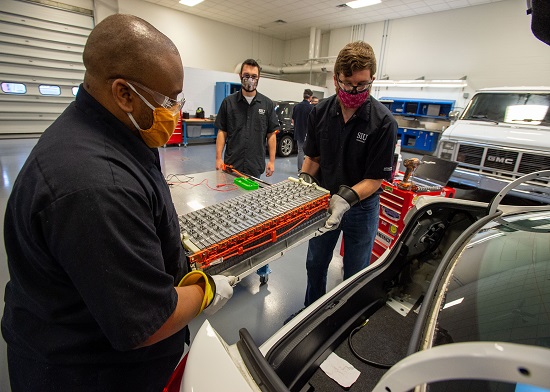 Students remove a battery-pack from a 2012 Toyota Camry hybrid to diagnose. (Color photos by Russell Bailey, University Communications and Marketing. Black and white photos courtesy of Special Collections Research Center, Morris Library.)
Students remove a battery-pack from a 2012 Toyota Camry hybrid to diagnose. (Color photos by Russell Bailey, University Communications and Marketing. Black and white photos courtesy of Special Collections Research Center, Morris Library.)
Student success, strong industry relationships and maintaining a deep family tradition among students and alumni remains critical, said Eugene Talley, the program’s interim director. No other program has the linkages to the automotive industry and partnerships that have been developed over time, said Talley, a 1993 graduate who returned to join the faculty in 2009.
“The strong program is the result of our students being very successful and of leading this industry,” he said. “It’s all about our students and what they are doing and showcasing their talents so much that the companies find SIU is the place to come and recruit.”
Share a long history
Mike Behrmann, an automotive program graduate who retired in May after more than 33 years as a faculty member, including 12 as department chair, notes the first automotive-related courses on campus were held in 1938. SIU Automotive began as a degree program in 1952 with founding program director L.D. Willey as a part of the university’s then-Vocational Technical Institute, spending nearly six decades in buildings near Carterville.
In a competitive admissions program for more than 20 years, there are about 300 students for the spring 2022 semester and close to 3,000 alumni. With between 12 and 15 baccalaureate automotive programs in the United States, SIU Automotive remains one of the few university-related automotive programs in the nation, Behrmann said.
“We work very closely with our students, and our students get to know us,” he said. “We work hard to maintain that family and that relationship well beyond after they graduate from the program. We develop lifelong friendships with our students.”
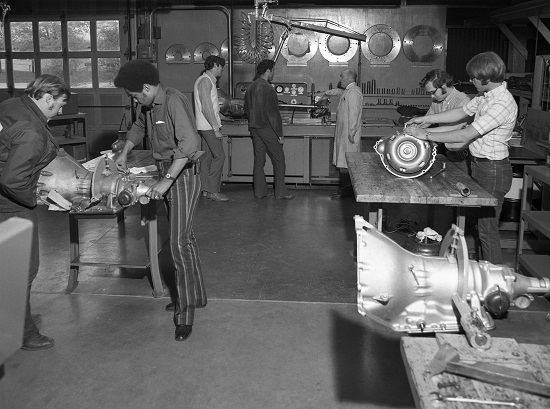 L.D. Willey, back right in lab coat, the automotive program’s first director, talks with two students while other students work on automatic transmissions in 1971.
L.D. Willey, back right in lab coat, the automotive program’s first director, talks with two students while other students work on automatic transmissions in 1971.
Talley, an associate professor, notes that alumni, faculty and staff sense the program’s legacy, consistency and desire to give back, with more than 10 faculty also being former students. The legacy of being only the fifth director in the program’s 70 years is “tremendous” and also a responsibility Talley doesn’t take lightly.
“What the other directors and chairs in the past have built, you don’t want to see that falter for a minute,” he said. “You don’t want to be the one of the five that doesn’t continue the traditions and successes we’ve had.”
Swartz said while he might not remember everything he studied at SIU, he won’t forget how the SIU Carbondale faculty and those in the automotive program made him feel.
“What I learned about automotive technology at SIU allowed me to understand the challenges facing technicians, dealers and manufacturers as they struggled to meet the expectations of customers in a complex and quickly evolving environment,” he said. “Throughout my career, I leaned heavily on my SIU-delivered knowledge of what goes on under the hood to make a difference in every position I held at Toyota Motor North America.”
Industry helps lead the program
The industry feedback SIU Automotive receives is invaluable. Talley notes that the program has “one of the largest and most active advisory panels of industry representatives to provide feedback and guidance of where we need to be.”
“We take their suggestions very seriously to maintain our program,” Talley said. “As the industry changes, so do we. As the industry is shifting to where we are going to see more electrification and electrical propulsion systems so you will see our curriculum and training shift and adjust.”
The program tries to maintain a fleet of about 130 vehicles, primarily provided by industry. But Talley notes that industry involvement doesn’t stop there. Countless components, tools, technical manuals, software, mentoring students and providing faculty with industry trends also tie into that industry support.
“There are many ways that these companies give that is critical for us to maintain the level of instruction that we have,” Talley said.
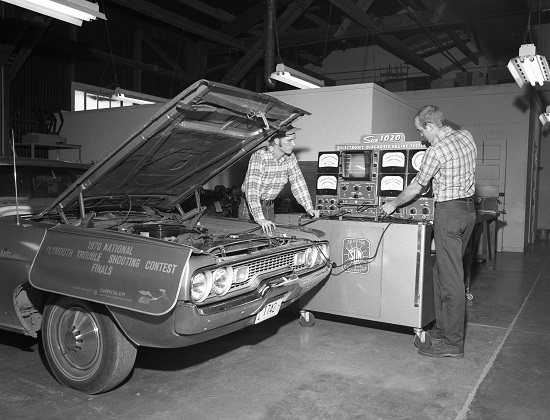 Students perform vehicle diagnostics during a class in 1971.
Students perform vehicle diagnostics during a class in 1971.
Graduates return to SIU and tell their stories to current students “and those experiences really help keep our students engaged and invigorated where they might end up,” he said.
Swartz said he felt connected to the program even after he graduated. He participated in annual automotive advisory committee meetings to stay in touch with the faculty and to visit the campus once a year. There, he began to share his experiences with students and over time found ways to “forge a relationship” between Toyota and SIU.
“While much of this relationship was based on recruiting graduates, we also supported SIU with Toyota training materials, technical publications and donations,” Swartz said. “Hopefully this relationship will continue to grow in the years to come benefiting both SIU and Toyota. As an SIU graduate, it is incumbent upon each of us to find ways to give back to those who made us who we are today.”
High placement rates help recruitment
Talley and Behrmann emphasize that an important component is parents who ask what their child can do with an automotive technology degree. The program has about 90% placement before graduation, with many companies employing students while they are in school through internships and available jobs outside of class.
“That is the very first thing that I show the parents and the first thing I talk about when I meet with parents: what is the payoff for their child to come to this program?” Talley said. “That is the fact that our ties to industry offer so many opportunities. These are the opportunities if students come and do their part.”
This year also marks the 10th anniversary of the opening of the Transportation Education Center for the automotive and aviation programs. Moving from dilapidated buildings in Carterville into a more efficient layout and facility that incorporates several services, demonstration and component laboratories, classrooms, fabrication lab and an in-house auto parts store allowed the program to steadily grow.
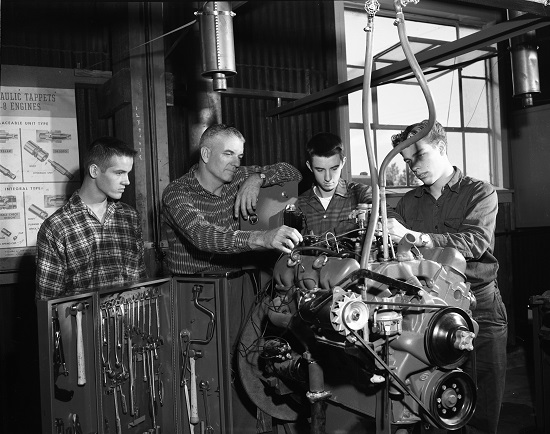 Students worked on a vehicle engine in 1960.
Students worked on a vehicle engine in 1960.
SIU’s state-of-the-art lab helps healthcare management students jumpstart their careers
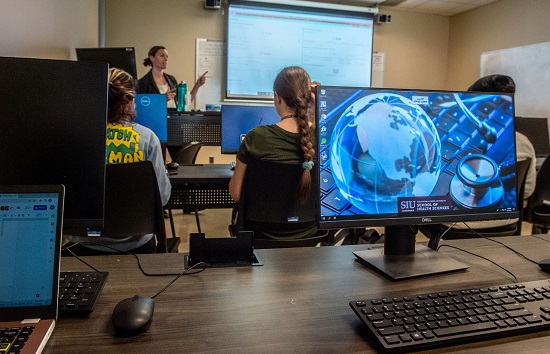 Jessica Cataldo, assistant professor of health care management, teaches students in the state-of-the-art Experiential Learning Lab for Informatics Education (ELLIE), where they receive hands-on training with specialized software programs to enhance their technical skills and prepare them for internships and jobs. (Photo by Russell Bailey)
Jessica Cataldo, assistant professor of health care management, teaches students in the state-of-the-art Experiential Learning Lab for Informatics Education (ELLIE), where they receive hands-on training with specialized software programs to enhance their technical skills and prepare them for internships and jobs. (Photo by Russell Bailey)
By Christi Mathis
CARBONDALE, Ill. — Thanks to a specialized lab and training offered at Southern Illinois University Carbondale, health care management graduates have an edge over many of their peers when they enter the job market, officials and graduates say. The system allows students to review patient medical records, analyze charts and risk factors for better patient outcomes, process billing data to facilitate revenue cycle improvements, review insurance claims data for accuracy and integrity, create disease outbreak models and more.
“The Experiential Learning Lab for Informatics Education, called ELLIE, is a cutting-edge and dynamic computer lab environment for the training of the health care workforce, both clinical and managerial,” said Jessica Cataldo, assistant professor of health care management.
The state-of-the-art lab, located in Room 60 in the ASA Building, west of the Banterra Center, features 40 computers with specialized software programs to enhance the technical skills of health care management students.
“Given the need for workforce readiness in health care analytics and informatics, making these learning opportunities possible for our students gives them a distinct advantage,” Cataldo said. “This training really improves our students’ job readiness. Employers tell us they require less training than other interns and new hires. And the training they have received at SIU also translates into the ability to use other health care management and informatics programs too.”
The training prepares students well for a fast-growing field, The U.S. Bureau of Labor Statistics anticipates a job growth rate of 32% for health care management in the decade ending in 2030.
Well-equipped and evolving
Courtesy of ELLIE, SIU’s health care program students are given access to some of the most advanced technology in the country, including EPIC, one of the premier electronic health care platforms, according to Cataldo and Kyle Triplett, clinical instructor of health care management. Triplett said it is very rare for a university to be able to offer in-house training with an electronic health records (EHR) program such as EPIC.
The program allows students to conduct a thorough review of charges and codes to assure everything is accurate so health care facilities can properly get paid. The process involves encrypted emails, many hours of training, and much more, beginning with a set reference point.
Students use the software to review patient charts, study risk factors, outcomes and other facets to assure the most favorable outcomes for treatment. In addition, they learn to navigate electronic health records, which Cataldo said can be tricky because sometimes providers enter notes in structured ways and sometimes randomly.
Students also use the high-tech programs to create disease outbreak models, which became even more relevant with the COVID-19 pandemic, according to Cataldo. They typically use simulation software to look at an influenza outbreak, tracking case numbers and locations, vaccinations, interactions and much more. Cataldo said in the last couple of years, these lessons really came alive for students as they saw the dramatic effects a disease or pandemic can have.
Despite the adjustments required in the last couple of years due to the pandemic, the scope of the ELLIE lab has already grown and proven instrumental in student success, officials said.
“There is so much potential here,” Cataldo said.
The lab was remodeled and updated with the latest technology shortly before the onset of the COVID-19 pandemic, with Southern Illinois Healthcare providing valuable assistance for the initiative by sharing time, training space and staff. SIH gives training opportunities to allow SIU’s health care management faculty and students access to its EPIC training modules and experts as well.
Numerous health care management classes meet in the same classroom and faculty are phasing in the usage of the ELLIE technology, a process that the pandemic slowed a bit. Triplett has integrated it into his health care finance class, and last semester, Cataldo incorporated it into her epidemiology/chart review class.
Prepared for internships and careers
The training health care management students receive in the ELLIE lab helps them prepare for required 150-hour internships and for their careers.
“This gives students valuable, critical experience with important programs and skills that they can put on their resumes,” Cataldo said.
Triplett said he has heard multiple stories about how well Salukis are doing.
“The preceptors overseeing our interns tell us that our students have much shorter learning curves and a broader scope of comprehension when it comes to health care management technology overall,” Kyle said. “It’s a big advantage because it translates directly to their ability to use skills that are utilized on a daily basis in the field of health care management. It’s hands-on learning that matters.”
Ricky Waldron, a senior health care management major from Herrin, Illinois, trained in ELLIE during his health information management class and said “getting electronic health record experience is vital in today’s health care world. Learning workflows in non-clinical areas, such as billing or running reports for quality, can help you prepare for your internship as well.”
He said working with the state-of-the-art system allowed him to apply classroom instruction to real-world situations.
“ELLIE does a great job helping students get a great baseline knowledge of how the health care system works and how to utilize the workflow skills that you will need for a career in health information or informatics,” Waldron said.
He is putting his training to good use this spring working an internship in the clinical informatics department at SIH. Moreover, well before he graduates next month, he had already accepted a position as an informatics specialist with a company that operates multiple health care clinics of various kinds in the metropolitan Charlotte, North Carolina, area. Waldron said it was definitely advantageous during his interview to be able to share details about his classroom experience and hands-on learning and how he was able to use that knowledge on various projects during his internship.
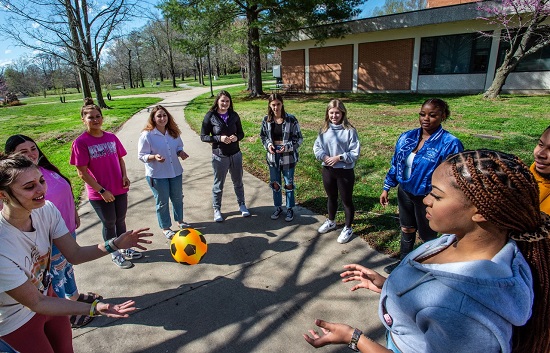 Students in one of Jessica Cataldo’s health care management classes recently participated in a creative learning experience simulating a process improvement project. The goal was to pass a ball back and forth as quickly as possible in a specified order, much as they would a task in the health care management field, and find ways to improve the efficiency of the process by communicating. (Photo by Russell Bailey)
Students in one of Jessica Cataldo’s health care management classes recently participated in a creative learning experience simulating a process improvement project. The goal was to pass a ball back and forth as quickly as possible in a specified order, much as they would a task in the health care management field, and find ways to improve the efficiency of the process by communicating. (Photo by Russell Bailey)
Creative learning
SIU’s health care management faculty employ other creative teaching techniques as well. On a recent spring day, the classroom moved outdoors and students divided into groups for a learning exercise.
The goal was to simulate a process improvement project. Each group of students had to pass a ball back and forth as fast as possible but in the same order, much as they would process a task when working in the health care management field. Sometimes they were aligned in a circle, sometimes in lines but always, they had to maintain the same order, regardless of position, and complete the task without dropping the ball. The students were required to talk, strategize and plan just as they would if handling a patient care file.
The groups competed to see which one could strategize to more quickly to complete the task in the most streamlined, expeditious, efficient way – just as they would handle a healthcare situation for the good of the patient and the institution, Cataldo said.
SIU criminal justice faculty, and students help evaluate community organizations
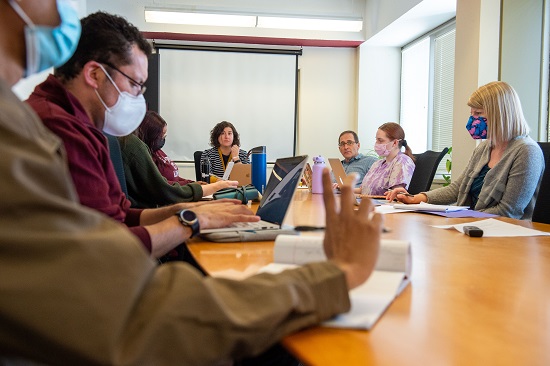 Criminology and criminal justice faculty Breanne Pleggenkuhle, center, Daryl Kroner, next right, and Audrey Hickert, far right, discuss with graduate students research work as part of the state program R3 — Restore. Reinvest. Renew. (Photo by Russell Bailey)
Criminology and criminal justice faculty Breanne Pleggenkuhle, center, Daryl Kroner, next right, and Audrey Hickert, far right, discuss with graduate students research work as part of the state program R3 — Restore. Reinvest. Renew. (Photo by Russell Bailey)
By Pete Rosenbery
CARBONDALE, Ill. — A research team in Southern Illinois University Carbondale’s criminology and criminal justice program is helping community organizations to assess and improve their effectiveness in providing services to neighborhoods in a large section of Southern Illinois and the Metro East impacted by economic disinvestment, violence and the war on drugs.
Professor Daryl Kroner, Associate Professor Breanne Pleggenkuhle and Assistant Professor Audrey Hickert, along with five master’s and doctoral students and two staff members, are involved in the research effort as part of R3 — Restore. Reinvest. Renew. via the Illinois Criminal Justice Information Authority.
Supported through the state’s Cannabis Regulation and Tax Act, the statewide initiative targets civil legal aid, economic development, reentry, violence prevention and youth development, Pleggenkuhle said. The reallocated funds go to local communities and agencies to target community-level issues and efforts.
Hickert said the research will provide a “fresh set of eyes and an independent perspective” that can improve the work each community organization is doing to keep it moving forward. “When you are in the midst of doing the work, sometimes you cannot see the forest for the trees,” she said.
SIU Carbondale is one of three research teams, with the University of Illinois Springfield and University of Illinois Chicago covering other programs and community organizations in other parts of the state. SIU received $160,000 for the first funding cycle that began in November and runs through end of the current fiscal year on June 30, with plans to reapply for fiscal year 2023.
Working with six sites
The SIU research team is now working with six groups to evaluate overall the types of programs that have been used, the associated challenges and successes, and how the organizations are addressing any obstacles. The actual evaluation of how the implemented plans are working will be in about two years, Kroner said.
The initial phase is about process and understanding how the organizations are implementing their programs. Four of the groups are service delivery sites and actively working, while two others, called assessment and planning sites, are determining their community needs before they also transition into service delivery sites, Kroner said.
The organizations involved are:
- Lutheran Social Services of Illinois, working with the program based in Marion.
- Arrowleaf, formerly the Family Counseling Center, based in Vienna.
- United Way of Greater St. Louis, operating within the boundaries of the East St. Louis School District 189.
- Academic Development Institute, based in Madison County.
- City of Harrisburg.
- Illinois Association of Juvenile Justice Councils based in Centralia.
Sites have program autonomy
Pleggenkuhle, Hickert and Kroner emphasize the programs are offered a great amount of autonomy in how they address goals. Later during the research, the team will talk more specifically to providers and staff about their efforts to determine not only “how things are going but are you reaching whom you want to be reaching” with services, Pleggenkuhle said.
Kroner added that Illinois has moved away from a philosophy that all intervention programs must operate the same.
“When things are too heavy top down and ideas are just forced down, it doesn’t work out,” he said. “There is no buy-in at the local level for it. You don’t have local businesses, local agencies getting excited about this intervention program, and overall for sustainability, it does not work.”
The SIU project will help the organizations succeed on their own terms, the researchers said.
The graduate students are helping with a lot of the groundwork and research and developing the protocols used for active data collection, allowing for hands-on research experience as it unfolds. They will also be observing during virtual meetings with members of the two other research teams in the state and the funding agency, learning the processes involved and gaining valuable experience.
Saluki student-athletes grateful for support to succeed during and after college
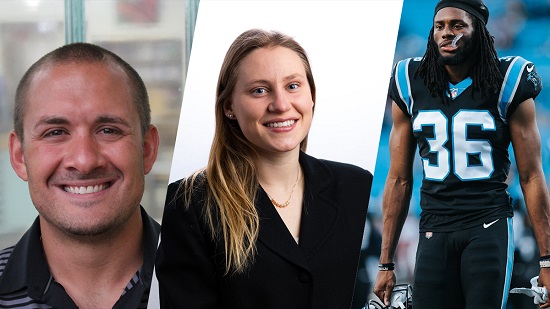 Anthony Colletti, Josie Brown and Madre Harper all chose SIU as the place to pursue their college degrees and continue their careers as student-athletes. (Provided photos)
Anthony Colletti, Josie Brown and Madre Harper all chose SIU as the place to pursue their college degrees and continue their careers as student-athletes. (Provided photos)
By Christi Mathis
CARBONDALE, Ill. — What do a Carolina Panthers football player, the guidance counselor for a 2,600-student Chicago-area high school and a standout college track/cross-country athlete with a 4.0 GPA have in common? When they are Madre Harper, Anthony Colletti and Josie Brown – the common denominator is that these former student-athletes all chose Southern Illinois University Carbondale as the launch pad to help them achieve their goals.
They say that SIU, and especially the personnel in the College of Health and Human Sciences and the athletic department, provided all of the support, help and even the “cheerleaders” crucial to their success.
Support and guidance
Today, Colletti works with Naperville Central high school students as a guidance counselor and football coach. A Park Ridge, Illinois, native and graduate of Maine South High School, he was drawn to SIU in 2005 for a number of reasons, including the fact that it was not too close and not too far away from home. And there was “a good balance” of benefits – including great scenery, friendly people, a nice pace and caring coaches, faculty and staff. Colletti was a scholarship nose tackle and defensive lineman for the Saluki football team at SIU for four years, graduating in 2010 with a health education degree including a physical education endorsement and minor in driver’s education.
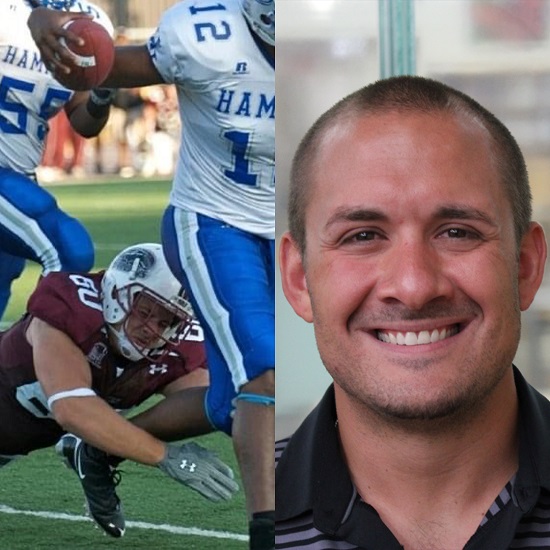 Tony Colletti, during his Saluki football career which ran from 2005 to 2009, and today, as a guidance counselor and football coach at Naperville Central High School. Colletti completed his health education teaching degree at SIU with a physical education endorsement/minor in 2010. (Provided photos)
Tony Colletti, during his Saluki football career which ran from 2005 to 2009, and today, as a guidance counselor and football coach at Naperville Central High School. Colletti completed his health education teaching degree at SIU with a physical education endorsement/minor in 2010. (Provided photos)
“I owe a lot of who I am today to SIU,” Colletti said. “When you are there, there are always eyes on you in the best ways possible. The professors are very supportive and nurturing. They guide and help you but don’t enable you. Another reason I picked Southern was the program was investing in student-athletes. It was an unbelievable 4½ years. Not everyone comes to college with great time and money management skills, but the faculty and athletic staff really work with the student-athletes at SIU.”
Colletti’s PE endorsement got him involved with SIU’s kinesiology department, where he had strong relationships. He was inspired to go into the education field “to be a positive influence on as many people as possible,” and he has added degrees and endorsements since graduating from SIU. Initially a physical education/driver’s education teacher, he became a special education teacher at Naperville North in hopes of having positive influence on even more students. He then became a guidance counselor in order to enhance the lives of even more people.
“I can’t say enough about SIU and all it’s done for me,” said Colletti, the father of four children under the age of 6, including twins, and a self-described fan of all teams Chicago (except the Cubs). “I loved the community and feel I had when I went there. You feel so connected and supported by everyone. To be honest, I’ve tried to create that same community-like culture in each stop I’ve been at after attending SIU.”
Getting pro-ready
Madre Harper, No. 36 on the Carolina Panthers roster, is in his second year with the team after spending time with the Giants and the Raiders. A native of Arlington, Texas, Harper transferred to SIU in 2018 after two years at Oklahoma State University, when one of his best friends told him how great SIU was.
“I came to visit and checked out the exercise science and football programs, and I was instantly interested,” Harper said. “I always wanted to be part of a place like this.”
 Madre Harper played for the SIU football team from 2018-2020, when he completed his degree in exercise science, and he’s now a member of the Carolina Panthers NFL squad. (Provided photos)
Madre Harper played for the SIU football team from 2018-2020, when he completed his degree in exercise science, and he’s now a member of the Carolina Panthers NFL squad. (Provided photos)
He was successful on the field at SIU, earning various accolades including honorable mention All- MVFC and ranking 17th in the nation for pass breakups. He succeeded in the classroom as well, graduating in 2020. Along the way, he made time to give to others, including volunteering as a trainer with the Strong Survivors cancer recovery program.
Juggling early morning workouts, practices, game schedules, classes and assignments and all of his other responsibilities was “very hard,” Harper admitted. But he also said the faculty at CHHS were very understanding about his schedule and helpful throughout his college career.
And that’s not all. He said the faculty and staff are true Saluki sports fans and vocal supporters of the student-athletes, offering reassurance, making personal connections, and posting comments and photos on social media to enhance student-athlete morale.
He said those relationships didn’t end when he graduated and joined the NFL. In fact, Phil Anton, professor and exercise science and Strong Survivors program director, still checks in on Harper and offers words of encouragement. His Panther teammate and fellow Saluki 2020 exercise science graduate Jeremy Chinn still gets those morale boosters, as well. In fact, Anton stays in contact with Colletti and numerous other students, as do many of the other CHHS faculty.
Creating a sense of community
Anton said he and his fellow faculty members care about all of their students and want them to know it.
“One of our big priorities is making sure we do everything we can to support what our students are doing in and out of the classroom,” Anton said. “That applies to our student-athletes and to all of our students involved in extracurricular activities as well as all Salukis on campus.”
Anton said CHHS faculty are perhaps especially empathetic with student-athletes because many, especially from exercise science and sport administration, have played sports at the college level.
“We know the time and effort required,” he said. “We don’t give them preferential treatment, but we do give them the benefit of the doubt when necessary.”
He said the college strives to create a sense of community with its students and one of the ways is for the college and departments to give the students social media shoutouts for their accomplishments – in the classroom and in their chosen sports. Whether it’s a home run, a personal best record, an academic honor, or service to the campus or community, “it helps them to know they’re being supported. They’re on the team for SIU and for their academic program.”
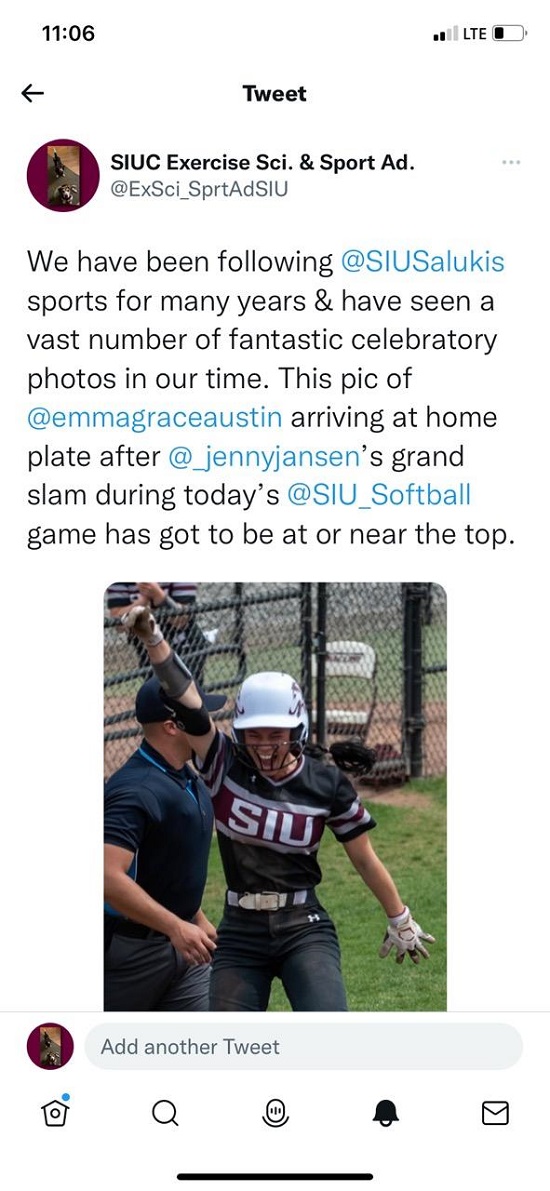
Anton said it’s very common for the faculty and staff to form personal connections with the students – including the student-athletes.
“We want them to know we have their backs,” he said. “We’re making the effort to be as supportive as we can and to get to know them, what’s important to them and how to help them reach their goals. And if they are going through a rough time, we want them to know we’re here for them.”
Saluki athletics support
Harper was also quick to note that Hilary Wittenborn, assistant athletic director for academics with Saluki Athletics, is always there to help student-athletes in a myriad of ways – from helping get classes and scheduling figured out to time management and simply lending a listening ear.
Wittenborn said her work with student-athletes begins even before they arrive on campus, helping them with orientation, acclimating to the D2L system, getting organized and learning time management skills.
Much of her time is devoted to CHHS student-athletes because they are a large portion of SIU’s student-athlete body. Of the 346 student-athletes campuswide, 153 come from CHHS. The School of Human Sciences alone has 89.
“We love that we have so many student-athletes in this department. It really makes us proud,” said Julie Partridge, professor of kinesiology, director of the Social Psychology of Sport Lab and NCAA faculty athletics representative (FAR), which is related to student-athlete welfare.
“Because we have so many student-athletes, we do all we can to support them in any way we can,” Partridge said. “We form close connections with them and promote what they’re doing on the field and in the classroom.”
Wittenborn said athletes have athletic training, practices and conditioning added to their classes and other responsibilities. She helps them establish plans to graduate with a meaningful degree and prepare for future success, and meets weekly with them help them to stay on track while complying with NCAA mandates. Wittenborn also connects them with other programming and services including financial literacy, mental health, career preparation and much more.
“A lot of my job is just encouraging them when they’re stressed about how they’re doing, reminding them to stay calm and focused on why they’re doing what they are doing. I encourage them to study hard and finish it out,” she said. “I remind them, ‘I believe in you. Let’s make sure you’re enjoying this.’”
Wittenborn, a first-generation college student herself, remembers firsthand the difficulties and struggles involved.
“It’s hard for athletes because they’re really focused on what they’re doing now, what they eat, their training, practices, academics and everything, and there’s so much on their plates,” Wittenborn said. “But SIU faculty are amazing. They are very helpful and really communicate with our student-athletes.”
Unique experiences
Josie Brown, a junior exercise science major from Geneseo in the Quad Cities area, excelled in track, cross-country and basketball in high school, and enjoyed playing sports all year long. SIU’s athletic programs, the campus and the “gorgeous” region quickly caught her attention. But the kinesiology/exercise science programs really pulled her in, and when she discovered Strong Survivors, the woman whose goal is to become a physical therapist was totally sold.
“That offered me an experience I couldn’t get anywhere else, since there’s only one other program like it in the country,” Brown said.
She said when she first arrived on campus, she had pretty good time management skills after a busy high school career and was convinced she had it all figured out. But like most students, she discovered there are obstacles, made even more difficult with the onset of the COVID-19 pandemic.
“But if you’re willing to put in the time and effort, it’s manageable,” she said. “If you go to the right university, with supportive faculty and staff, you can make it work. SIU has great people, super welcoming. As long as you communicate with them, they are very understanding and cooperative. They are really very supportive of the student-athletes.”
Her schedule keeps her busy year-round, but she still manages to maintain a 4.0 GPA and she’s in her fourth semester as a student trainer in Strong Survivors.
Anton said the fact that Brown, Harper and many of SIU’s student-athletes already have such full schedules but still find time to give back to the community further endears them to their supporters. At any given time, he said, you’ll find numerous student-athletes volunteering their time and energy serving as trainers for the Strong Survivors cancer recovery program. The Salukis also help with Big Brothers/Big Sisters, toy drives, Scouting events and other charitable and community activities.
Brown admits juggling everything is a challenge but said she has benefitted as well. She said she is amazed and impressed with the cancer survivors and caregivers she’s become acquainted with through Strong Survivors, an exercise and nutritional program for cancer survivors and caregivers. Her work as a trainer and researcher in the lab has also led her to do a little rethinking of her career plans. While she’s determined to go into physical therapy, she may get her master’s degree in exercise science or biomedical engineering with a focus on biomechanics and then go on to physical therapy school so she can get involved in the research aspect of the field. “It’s such a diverse field,” she said. “Research on Parkinson’s disease or other neuromuscular diseases may be in my future.”
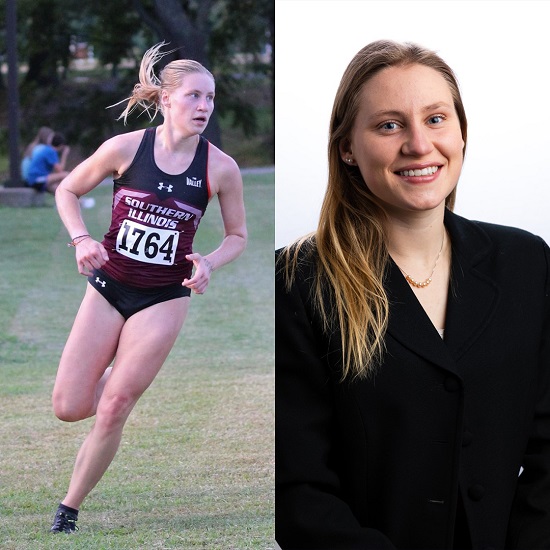 Josie Brown is a junior exercise science major at SIU and competes on the track and cross-country teams. She is preparing for a career as a physical therapist and will potentially be involved in related research after completing her education. (Provided photos)
Josie Brown is a junior exercise science major at SIU and competes on the track and cross-country teams. She is preparing for a career as a physical therapist and will potentially be involved in related research after completing her education. (Provided photos)
Forming additional connections
Many CHHS student-athletes, including all sport admin majors must serve internships, and a large number of them do so with Saluki Athletics, strengthening the bonds between academics and athletics.
“It’s a great opportunity for students to be able to work in Division I athletics, a good way for the students to form valuable connections and network, and an excellent springboard to jobs in the industry,” Wittenborn said.
Wittenborn said she and the rest of the athletics staff introduce the interns to the diverse areas – including marketing, sports medicine, scholarships, compliance, communications, the various teams, facilities and much more – making sure they get experiences that correlate with their areas of interest.
“It really gives them an appreciation for what all that goes into producing athletic events,” Wittenborn said.

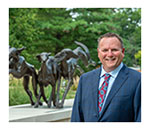 Welcome to the spring 2022 e-newsletter for the College of Health and Human Sciences at Southern Illinois University Carbondale.
Welcome to the spring 2022 e-newsletter for the College of Health and Human Sciences at Southern Illinois University Carbondale. For Phil Anton, associate professor and director of the exercise science program, his work in establishing Strong Survivors, one of only two programs of its kind for cancer survivors in the country, has personal meaning. Now in a new facility on campus, the program provides exercise training space a couple of days each week and includes nutrition and fitness components.
For Phil Anton, associate professor and director of the exercise science program, his work in establishing Strong Survivors, one of only two programs of its kind for cancer survivors in the country, has personal meaning. Now in a new facility on campus, the program provides exercise training space a couple of days each week and includes nutrition and fitness components. Whether the work was in temporary military buildings or a state-of-the-industry facility, the strength of the university’s nationally recognized automotive program continues to resonate through seven decades.
Whether the work was in temporary military buildings or a state-of-the-industry facility, the strength of the university’s nationally recognized automotive program continues to resonate through seven decades. Thanks to a specialized lab and training offered at SIU Carbondale, healthcare management graduates have an edge over many of their peers when they enter the job market, officials and graduates say. The system allows students to review patient medical records, analyze charts and risk factors for better patient outcomes, process billing data to facilitate revenue cycle improvements, review insurance claims data for accuracy and integrity, create disease outbreak models, and more.
Thanks to a specialized lab and training offered at SIU Carbondale, healthcare management graduates have an edge over many of their peers when they enter the job market, officials and graduates say. The system allows students to review patient medical records, analyze charts and risk factors for better patient outcomes, process billing data to facilitate revenue cycle improvements, review insurance claims data for accuracy and integrity, create disease outbreak models, and more.